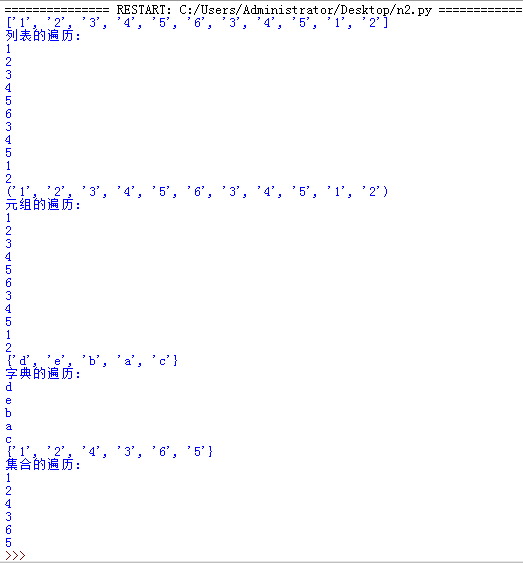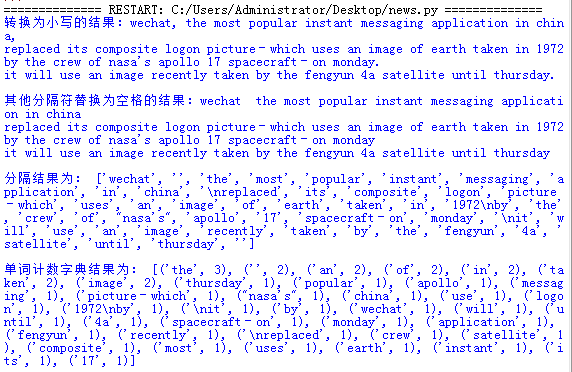组合数据类型练习,英文词频统计实例上
1.字典实例:建立学生学号成绩字典,做增删改查遍历操作。
#建立学生学号成绩字典
d={'001':88,'002':78,'003':82,'004':75,'005':92,'006':87,'007':67,'008':79}
#增加学生成绩
d['009']=94
#删除学生成绩
d.pop('008')
#修改学生成绩
d['007']=70
#查询学生成绩
d['005']
for i in d:
print(i,d[i])

2.列表,元组,字典,集合的遍历。
总结列表,元组,字典,集合的联系与区别。
s1=list('12345634512')
print(s1)
print('列表的遍历:')
for i in s1:
print(i)
s2=tuple('12345634512')
print(s2)
print('元组的遍历:')
for i in s2:
print(i)
d={'a','b','c','d','e'}
print(d)
print('字典的遍历:')
for i in d:
print(i)
s3=set('12345634512')
print(s3)
print('集合的遍历:')
for i in s3:
print(i)

列表:列表list 是一种有序的序列,正向递增、反向递减序号。可以随时对元素进行增删改,元素的类型可以不同,没有长度的限制。
元组:元组tuple和列表非常相似,但元组一旦初始化就不能修改。
字典:dic使用键-值(key-value)存储,其中键必须是不可变的对象。
集合:set没有重复的值,是无序的。
3.英文词频统计实例
- 待分析字符串
- 分解提取单词
- 大小写 txt.lower()
- 分隔符'.,:;?!-_’
- 单词列表
- 单词计数字典
news='''WeChat, the most popular instant messaging application in China,
replaced its composite logon picture-which uses an image of Earth taken in 1972
by the crew of NASA's Apollo 17 spacecraft-on Monday.
It will use an image recently taken by the Fengyun 4A satellite until Thursday.'''
#将所有大写转换为小写
news=news.lower()
print('转换为小写的结果:'+news+'\n')
#将所有分隔符'.,:;?!-_’替换为空格
for i in '.,:;?!-_':
news=news.replace(i,' ')
print('其他分隔符替换为空格的结果:'+news+'\n')
#分隔出一个一个单词
news=news.split(' ')
print('分隔结果为:',news,'\n')
#单词计数字典
word=set(news)
dic={}
for i in word:
dic[i]=news.count(i)
news=list(dic.items())
news.sort(key=lambda x:x[1],reverse=True)
print('单词计数字典结果为:',news,'\n')

智能推荐
注意!
本站转载的文章为个人学习借鉴使用,本站对版权不负任何法律责任。如果侵犯了您的隐私权益,请联系我们删除。
